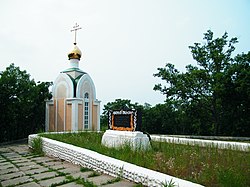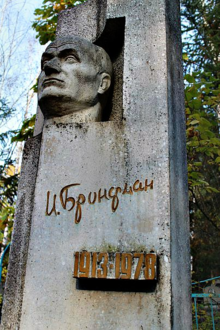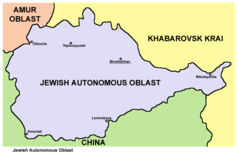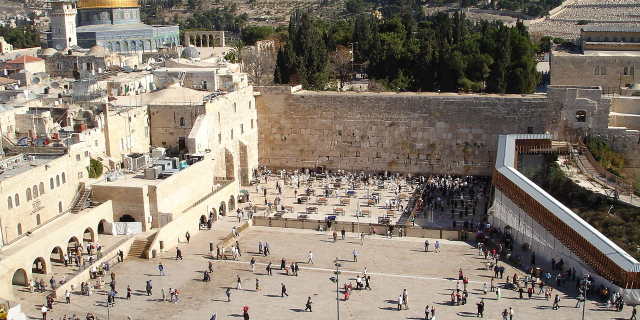Jewish Autonomous Oblast
The Jewish Autonomous Oblast (JAO; Russian: Евре́йская автоно́мная о́бласть (ЕАО), romanized: Yevreyskaya avtonomnaya oblast; Yiddish: ייִדישע אװטאָנאָמע געגנט, IPA: [jɪdɪʃə avtɔnɔmə ɡɛɡnt]) is a federal subject of Russia situated in the far east of the country, bordering Khabarovsk Krai and Amur Oblast in Russia and Heilongjiang province in China. Its administrative center is the town of Birobidzhan.
The JAO was designated by a Soviet official decree in 1928, and officially established in 1934. At its height, in the late 1940s, the Jewish population in the region peaked around 46,000–50,000, approximately 25% of ...Read more
The Jewish Autonomous Oblast (JAO; Russian: Евре́йская автоно́мная о́бласть (ЕАО), romanized: Yevreyskaya avtonomnaya oblast; Yiddish: ייִדישע אװטאָנאָמע געגנט, IPA: [jɪdɪʃə avtɔnɔmə ɡɛɡnt]) is a federal subject of Russia situated in the far east of the country, bordering Khabarovsk Krai and Amur Oblast in Russia and Heilongjiang province in China. Its administrative center is the town of Birobidzhan.
The JAO was designated by a Soviet official decree in 1928, and officially established in 1934. At its height, in the late 1940s, the Jewish population in the region peaked around 46,000–50,000, approximately 25% of its population. By 1959, its Jewish population had fallen by half, and by 1989, with emigration restrictions removed, Jews made up 4% of its population. By 2010, according to census data, there were only approximately 1,600 people of Jewish descent remaining in the JAO (or just under 1% of the total population of the JAO and around 1% of Jews in the country), while ethnic Russians made up 93% of its population. According to the 2021 census, there were only 837 ethnic Jews left in the JAO (0.6%).
Article 65 of the Constitution of Russia provides that the JAO is Russia's only autonomous oblast. It is one of two officially Jewish jurisdictions in the world, the other being Israel.
Prior to 1858, the area of what is today the Jewish Autonomous Oblast was ruled by a succession of Chinese imperial dynasties. In 1858, the northern bank of the Amur River, including the territory of today's Jewish Autonomous Oblast, was split away from the Qing Chinese territory of Manchuria and became incorporated into the Russian Empire pursuant to the Treaty of Aigun (1858) and the Convention of Peking (1860).
Military colonizationIn December 1858, the Russian government authorized the formation of the Amur Cossack Host to protect the south-east boundary of Siberia and communications on the Amur and Ussuri rivers.[1] This military colonization included settlers from Transbaikalia. Between 1858 and 1882, many settlements consisting of wooden houses were founded.[2] It is estimated that as many as 40,000 men from the Russian military moved into the region.[2]
Expeditions of scientists, including geographers, ethnographers, naturalists, and botanists such as Mikhail Ivanovich Venyukov, Leopold von Schrenck, Karl Maximovich, Gustav Radde, and Vladimir Leontyevich Komarov promoted research in the area.[1]
Construction of the Trans-Siberian RailwayIn 1899, construction began on the regional section of the Trans-Siberian Railway connecting Chita and Vladivostok. The project produced a large influx of new settlers and the foundation of new settlements. Between 1908 and 1912, stations opened at Volochayevka, Obluchye, Bira, Birakan, Londoko, In, and Tikhonkaya. The railway construction finished in October 1916 with the opening of the 2,590-metre (8,500 ft) Khabarovsk Bridge across the Amur at Khabarovsk.
During this time, before the 1917 revolution, most local inhabitants were farmers.[1] The only industrial enterprise was the Tungussky timber mill, although gold was mined in the Sutara River, and there were some small railway workshops.[1]
Russian Civil WarIn 1922, during the Russian Civil War, the territory of the future Jewish Autonomous Oblast became the scene of the Battle of Volochayevka.[3]
Soviet policies regarding minorities and JewsAlthough Judaism as a religion ran counter to the Bolshevik party's policy of atheism and their crackdown on organized Jewish communities by closing synagogues and harassing believers, Vladimir Lenin also wanted to appease minority groups to gain their support and provide examples of tolerance.[4]
In 1924, the unemployment rate among Jews exceeded 30%,[5] as a result of USSR policies against private property ownership, which prohibited them from being craftspeople and small businessmen as many had been prior to the revolution.[6] With the goal of getting Jews back to work to be more productive members of society, the government established Komzet, the committee for the agricultural settlement of Jews.[5] The Soviet government entertained the idea of resettling all Jews in the USSR in a designated territory where they would be able to pursue a lifestyle that was "socialist in content and national in form". The Russians also wanted to offer an alternative to Zionism, the establishment of the Mandate of Palestine as a Jewish homeland. Socialist Zionists such as Ber Borochov were gaining followers at that time, and Zionism was the favored ideology in the world's political economy to the Yiddish interpretations, which were essentially incompatible with the USSR because of the Yiddish movement's growing opposition (e.g. Emma Goldman) to the very ethno-nationalism which constituted and structured Soviet states.[1]
Crimea was initially considered in the early 1920s, when it already had a significant Jewish population.[1] Two Jewish districts (raiony) were formed in Crimea and three in south Ukraine.[5][7] However, an alternative scheme, perceived as more advantageous, was put into practice.[1]




Eventually, Birobidzhan, in what is now the JAO, was chosen by the Soviet leadership as the site for the Jewish region.[8] The choice of this area was a surprise to Komzet; the area had been chosen for military and economic reasons.[4] This area was often infiltrated by China, while Japan also wanted Russia to lose the provinces of the Soviet Far East. At the time, there were only about 30,000 inhabitants in the area, mostly descendants of Trans-Baikal Cossacks resettled there by tsarist authorities, Koreans, Kazakhs, and the Tungusic peoples.[9] The Soviet government wanted to increase settlement in the remote Russian Far East, especially along the vulnerable border with China. General Pavel Sudoplatov writes about the government's rationale behind picking the area in the Far East: "The establishment of the Jewish Autonomous Oblast in Birobidzhan in 1928 was ordered by Stalin only as an effort to strengthen the Far Eastern border region with an outpost, not as a favour to the Jews. The area was constantly penetrated by Chinese and White Russian resistance groups, and the idea was to shield the territory by establishing a settlement whose inhabitants would be hostile to white Russian émigrés, especially the Cossacks. The status of this region was defined shrewdly as an autonomous district, not an autonomous republic, which meant that no local legislature, high court, or government post of ministerial rank was permitted. It was an autonomous area, but a bare frontier, not a political center."[10]
On 28 March 1928, the Presidium of the General Executive Committee of the USSR passed the decree "On the attaching for Komzet of free territory near the Amur River in the Russian Far East for settlement of the working Jews."[11] The decree meant "a possibility of establishment of a Jewish administrative territorial unit on the territory of said region".[1][11]
The new territory was initially called the Birobidzhan Jewish National Raion.[4]
Birobidzhan had a harsh geography and climate: it was mountainous, covered with virgin forests of oak, pine and cedar, and also swamplands, and any new settlers would have to build their lives from scratch. To make colonization more enticing, the Soviet government allowed private land ownership. This led to many non-Jews settling in the oblast to get a free farm.[12]
In the spring of 1928, 654 Jews arrived to settle in the area; however, by October 1928, 49.7% of them had left because of the severe conditions.[4] In the summer of 1928, there were torrential rains that flooded the crops and an outbreak of anthrax that killed the cattle.[13]
On 7 May 1934, the Presidium of the General Executive Committee accepted the decree on its transformation into the Jewish Autonomous Region within the Russian Soviet Federative Socialist Republic.[1] In 1938, with the formation of the Khabarovsk Territory, the Jewish Autonomous Region (JAR) was included in its structure.[11]
Growth of Jewish communities in the early 1930s


In the 1930s, a Soviet promotional campaign was created to entice more Jewish settlers to move there. The campaign partly incorporated the standard Soviet promotional tools of the era, including posters and Yiddish-language novels describing a socialist utopia there. In one instance, leaflets promoting Birobidzhan were dropped from an airplane over a Jewish neighborhood in Belarus. In another instance, a government-produced Yiddish film called Seekers of Happiness told the story of a Jewish family from overseas making a new life for itself in Birobidzhan.[1]
Early Jewish settlements included Valdgeym, dating from 1928, which included the first collective farm established in the oblast,[14] Amurzet, which was the center of Jewish settlement south of Birobidzhan from 1929 to 1939,[15] and Smidovich.
The Organization for Jewish Colonisation in the Soviet Union, a Jewish Communist organization in North America, successfully encouraged the immigration of some US residents, such as the family of the future spy George Koval, which arrived in 1932.[1][16] Some 1,200 non-Soviet Jews chose to settle in Birobidzhan.[1][8]
As the Jewish population grew, so did the impact of Yiddish culture on the region. The settlers established a Yiddish newspaper, the Birobidzhaner Shtern; a theatre troupe was created; and streets being built in the new city were named after prominent Yiddish authors such as Sholom Aleichem and I. L. Peretz.[17]
Stalin era and World War IIThe Jewish population of JAO reached a pre-war peak of 20,000 in 1937.[18] According to the 1939 population census, 17,695 Jews lived in the region (16% of the total population).[11][19]
After the war ended in 1945, there was renewed interest in the idea of Birobidzhan as a potential home for Jewish refugees. The Jewish population in the region peaked at around 46,000–50,000 Jews in 1948, around 25% of the entire population of the JAO.[20]
Cold WarThe census of 1959 found that the Jewish population of the JAO had declined by approximately 50%, down to 14,269 persons.[19]
A synagogue was opened at the end of World War II, but it closed in the mid-1960s after a fire left it severely damaged.[21]
In 1980, a Yiddish school was opened in Valdgeym.[22]
In 1987, the reformist Soviet government led by Mikhail Gorbachev pardoned many political prisoners and told the American Jewish community that it would allow the emigration of 11,000 Jewish refuseniks.[23] According to the 1989 Soviet Census, there were 8,887 Jews living in the JAO, or 4% of the total JAO population of 214,085.[4]
Post-Soviet history Birobidzhaners arriving in Israel,
Birobidzhaners arriving in Israel,23 March 1993.
In 1991, after the breakup of the Soviet Union, the Jewish Autonomous Oblast became the federal subject of Russia and thus was no longer subordinated to Khabarovsk Krai. However, by that time, most of the Jews had emigrated from the Soviet Union and the remaining Jews constituted fewer than 2% of the local population.[17] In early 1996, 872 people, or 20% of the Jewish population at that time, emigrated to Tel Aviv via chartered flights.[24] As of 2002, 2,357 Jews were living in the JAO.[19] A 2004 article stated that the number of Jews in the region "was now growing".[25] As of 2005, Amurzet had a small active Jewish community.[26] An April 2007 article in The Jerusalem Post claimed that the Jewish population had grown to about 4,000. The article cited Mordechai Scheiner, the Chief Rabbi of the JAO from 2002 to 2011, who said that, at the time the article was published, Jewish culture was enjoying a religious and cultural resurgence.[27] By 2010, according to data provided by the Russian Census Bureau, there were only approximately 1,600 people of Jewish descent remaining in the JAO (1% of the total population), while ethnic Russians made up 93% of the JAO population.[28]
According to an article published in 2000, Birobidzhan has several state-run schools that teach Yiddish, a Yiddish school for religious instruction and a kindergarten. The five- to seven-year-olds spend two lessons a week learning to speak Yiddish, as well as being taught Jewish songs, dance, and traditions.[29] A 2006 article in The Washington Times stated that Yiddish is taught in the schools, a Yiddish radio station is in operation, and the Birobidzhaner Shtern newspaper includes a section in Yiddish.[30]
 Memorial for Jewish poet Isaac Leibovich Bronfman.
Memorial for Jewish poet Isaac Leibovich Bronfman.In 2002, L'Chayim, Comrade Stalin!, a documentary on Stalin's creation of the Jewish Autonomous Region and its settlement, was released by The Cinema Guild. In addition to being a history of the creation of the Jewish Autonomous Oblast, the film features scenes of contemporary Birobidzhan and interviews with Jewish residents.[31]
According to an article published in 2010, Yiddish is the language of instruction in only one of Birobidzhan's 14 public schools. Two schools, representing a quarter of the city's students, offer compulsory Yiddish classes for children aged 6 to 10.[32][33]
As of 2012, the Birobidzhaner Shtern continues to publish 2 or 3 pages per week in Yiddish and one local elementary school still teaches Yiddish.[32]
According to a 2012 article, "only a very small minority, mostly seniors, speak Yiddish", a new Chabad-sponsored synagogue opened at the 14a Sholom-Aleichem Street, and the Sholem Aleichem Amur State University offers a Yiddish course.[21]
According to a 2015 article, kosher meat arrives by train from Moscow every few weeks, a Sunday school functions, and there is also a minyan on Friday night and Shabbat.[34]
A November 2017 article in The Guardian, titled, "Revival of a Soviet Zion: Birobidzhan celebrates its Jewish heritage", examined the current status of the city and suggested that, even though the Jewish Autonomous Region in Russia's far east is now barely 1% Jewish, officials hope to woo back people who left after Soviet collapse.[35]
2013 proposals to merge the JAO with adjoining regionsIn 2013, there were proposals to merge the JAO with Khabarovsk Krai or with Amur Oblast.[1] The proposals led to protests,[1] and were rejected by residents,[36] as well as the Jewish community of Russia. There were also questions as to whether a merger would be allowed pursuant to the Constitution of Russia and whether a merger would require a national referendum.[1]

































Add new comment